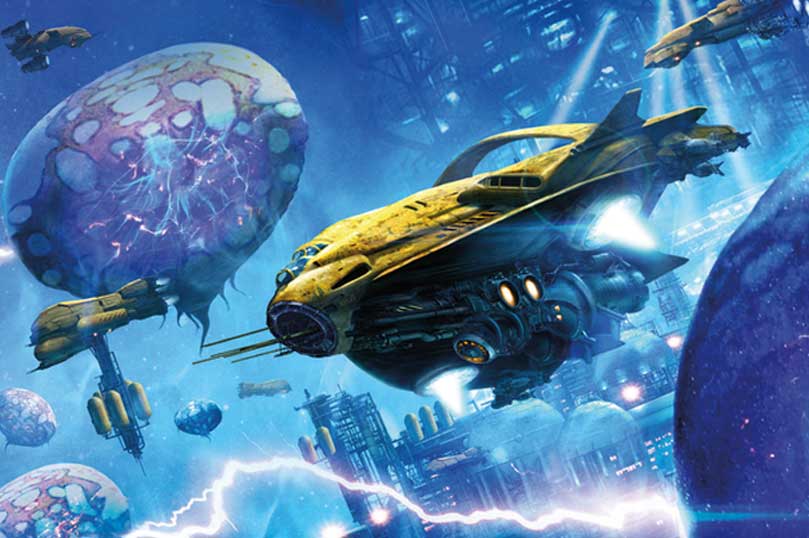Peter F. Hamilton is best known for his epic space operas set in futures where the human race has spread to the stars and he is one of my all-time favourite authors
. His books such as The Reality Dysfunction, Fallen Dragon, Pandora's Star and Great North Road are sci-fi masterpieces. His next novel Salvation begins a new trilogy and is due in bookshops on September 4th, 2018.

About both the distant future of humanity and how we get there, Salvation follows two storylines: the first is set in the year 2204, where humanity has spread throughout the galaxy, thanks to a system of advanced gates that allows them to travel instantaneously between planets. Spaceships have become all but obsolete, but when a crashed alien spacecraft is found on a newly-discovered world, a team is sent out to investigate it and the strange cargo that it carries. The other storyline is set in the 51st century, following a genetically engineered group of soldiers designed to confront an ancient enemy, bent on hunting humans to extinction.
Anyway, here is a small excerpt released as a teaser by the publisher Penguin Random House. I think you'll agree that the plot idea sounds quite intriguing. I can't wait! Enjoy...
Earth Calling
Drifting through interstellar space, three light-years out from the star 31 Aquilae, the Neána abode cluster picked up a series of short, faint electromagnetic pulses that lasted intermittently for eighteen years. The early signatures were familiar to the Neána, and faintly worrying: nuclear fission detonations, followed seven years later by fusion explosions. The technological progress of whoever was detonating them was exceptionally swift by the usual metric of emerging civilizations.
Metaviral spawn chewed into the cometry chunks that anchored the vast cluster, spinning out a string of flimsy receiver webs twenty kilometers across. They aligned themselves on the G-class star fifty light-years away, where the savage weapons were being deployed.
Sure enough, a torrent of weak electromagnetic signals was pouring out from the star’s third planet. A sentient species was entering into its early scientific industrial state.
The Neána were concerned that so many nuclear weapons were being used. Clearly, the new species was disturbingly aggressive. Some of the cluster’s minds welcomed that.
Analysis of the radio signals, now becoming analogue audiovisual broadcasts, revealed a bipedal race organized along geo-tribal lines, and constantly in conflict. Their specific biochemical composition was one that, from the Neána perspective, gave them sadly short lives. That was posited as the probable reason behind their faster than usual technological progression.
That there would be an expedition was never in doubt; the Neána saw that as their duty no matter what kind of life evolved on distant worlds. The only question now concerned the level of assistance to be offered. Those who welcomed the new species’ aggressive qualities wanted to make the full spectrum of Neána technology available. They almost prevailed.
The spherical insertion ship that left the cluster—it didn’t know if it was one of many being dispatched, or alone—measured a hundred meters in diameter, a mass comprised of active molecule blocks. It spent three months accelerating up to thirty percent of light speed along a course to Altair—a trip that took just over a hundred years. During the lonely voyage the ship’s controling sentience continued to monitor the electromagnetic signals coming from the young civilization that was its ultimate goal. It built up an impressive knowledge base of human biology, as well as a comprehensive understanding of their constantly evolving tribal political and economic structures.
When the ship reached Altair, it performed a complex flyby maneuver, which aligned it perfectly on Sol. After that, the physical section of the sentience’s memory that contained all the astrogration data of the flight from the cluster to Altair was jettisoned and the constituent blocks deactivated. Its weakened atomic structure broke apart into an expanding cloud of dust, which was quickly dispersed by Altair’s solar wind. Now, if it was ever intercepted, the insertion ship could never betray the position of the Neána abode cluster—for it no longer knew where it was.
The last fifty years of the voyage were spent formatting an emplacement strategy. By now, human ingenuity had produced starships that were flying past the insertion ship in the other direction, in quest of new worlds out among the stars. The information blasting out from Earth and the solar system’s asteroid habitats had become increasingly sophisticated, yet, conversely, there was a lot less of it. Radio signals had been in decline since the internet had begun to carry the bulk of human data traffic. For the final twenty years of the insertion ship’s approach it received little apart from entertainment broadcasts, and even those were shrinking year by year. But it had enough.
It flew in south of the ecliptic, shedding cold mass in irregular bursts like a black comet—a deceleration maneuver that took three years. This was always the riskiest part of the voyage. The humans’ solar system was scattered with a great many astronomical sensors scanning the universe for cosmological abnormalities. By the time it passed the Kuiper belt, the insertion ship was down to twenty-five meters in diameter. It emitted no magnetic or gravitational fields. The outer shell was fully radiation absorbent, so there was no albedo, making it invisible to any telescopes. Thermal emission was zero.
No one perceived its arrival.
Inside, four biologics began to grow within molecular initiators, attaining physical patterns the ship’s sentience had designed, based on the information it had acquired during the long voyage.
They were human in size and shape; skeletons and organs carried the mimicry down to a biochemical level. Their DNA was equally authentic. You would have to go a lot deeper into the cells to find any abnormality; only a detailed audit of the organelles would reveal alien molecular structures.
It was the minds of the biologics that gave the insertion ship the greatest difficulty. Human mental processes were complex verging on paradoxical. Worse, it suspected the performances in all the fictional dramas it received were overemphasizing emotional responses. So it constructed a stable primary architecture of thought routines, while including a fast learning and adaptive integration procedure.
As it closed to within a million kilometers of Earth, the insertion ship discarded the last of its reaction mass as it performed a final deceleration maneuver. Now it was basically just falling toward the southernmost tip of South America. Tiny course correction ejecta refined the descent vector, steering it at Tierra del Fuego, which was still thirty minutes from greeting the dawn. Even if it was detected now, it would simply appear to be a small chunk of natural space debris.
It hit the upper atmosphere and began to peel apart into four pear-shaped segments. The remaining matter broke away in fizzing sparks that produced a short-lived but beautiful starburst display streaking through the mesosphere. Below it, sheltered under their blanket of thick winter cloud, the residents of Ushuaia, the southernmost city on Earth, remained oblivious of their interstellar visitor.
Each segment carried on down, aerobraking with increasing severity as the atmosphere thickened around them. They slowed to subsonic velocity three kilometers above the surface, plunging through the clouds, still unobserved by anyone on the planet.
The segments were aimed at a small inlet a few kilometers west of the city, where, even in AD 2162, the rugged land lay unclaimed by developers. Two hundred meters from the shore, four tall splash plumes shot up into the air like thick geysers, crowning and splattering down on the slushy ice that bobbed along the waters of the Beagle Channel.
The Neána metahumans floated to the surface. All that now remained of the insertion ship landing segments was a thick layer of active molecule blocks covering their skin like a pelt of translucent gel, insulating them from the dangerously cold water. They began to swim ashore.
The beach was a narrow strip of gray stones cluttered with dead branches. A dense woodland occupied the slope above it. The aliens scrambled a short way up the incline as the pale dawn light began to seep through the murky clouds. Their protective layer liquidized, draining down into the stones where it would be flushed away by the next high tide. For the first time, they drew air down into their lungs.
“Oh, that is cold!” one exclaimed.
“Good classification,” another agreed through chattering teeth. “I’ll go with it.”
They looked at one another in the gray light. Two were crying from the emotional impact of arrival, one was smiling in wonder, while the fourth appeared singularly unimpressed by the bleak landscape. Each carried a small pack of outdoor clothing copied from a winter wear ad broadcast eighteen months earlier. They hurried to put it on.
When they were fully dressed, they set off along an ancient track up through the trees until they came to the remnants of National Route Three, which led to Ushuaia.
© Penguin Random House





